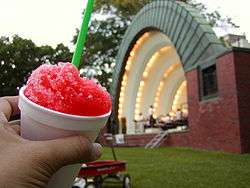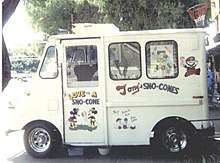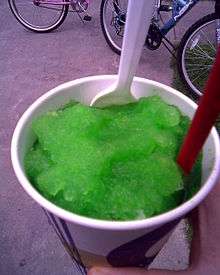Snow cone
Snow cones are a variation of shaved ice or ground-up ice desserts commonly served in paper cones or foam cups.[1] Although if it is in a cup, it is commonly referred to as a 'snowball'. The dessert consists of ice shavings that are topped with flavored sugar syrup.
 Snow cone with cherry syrup | |
| Type | Shaved ice |
|---|---|
Depending on the region of North America, the terms "snowball" and "snow cone" may refer to different things. Where the distinction is made, the former refers to a dessert made of finely shaved ice ("like soft fresh snow"), while the latter contains ground-up ice that is coarser and more granular ("crunchy").
History

Industrial Revolution
In the 1850s, the American Industrial Revolution made ice commercially available. Ice houses in New York would commonly sell ice to places like Florida. To transport the ice to Florida, the ice houses would send a wagon with a huge block of ice south. The route to Florida would pass right through Baltimore where children would run up to the wagon and ask for a small scraping of ice. Before long, mothers started to make flavoring in anticipation of their children receiving some ice. The first flavor the women made is still a Baltimore favorite: egg custard. Egg custard was an easy flavor to make as the only ingredients were eggs, vanilla, and sugar.[2]
Theaters
By the 1870s, the snowball's popularity had risen to the degree that in the warm summer months, theaters would sell snowballs to keep their patrons cool. Because of this association with the theater, snowballs were thought of as an upper-class commodity. Signs in theaters instructing patrons to finish their snowballs before coming in to the second act are the earliest tangible evidence of snowballs. In the theaters in Baltimore during the time hand shavers were used to shave the ice. Around the city, snowballs were served on newspaper, but in the classy theaters, butchers' boats were used. In the 1890s, many people started to invent easier ways to make snowballs. In that decade, patents for electric ice shavers were filed.[3][4]
Great Depression and World War II
During the Great Depression and World War II, snowballs became available outside of Baltimore. As snowballs were so cheap, they were one of the few treats that people could afford. This inexpensiveness earned snowballs the nicknames Hard Times Sundae and Penny Sunday. People in need of a job could sell snowballs, as it required little overhead. The treat became more popular during World War II, when all available ice cream was sent to soldiers, creating a need for an icy treat. This newfound lack of competition helped snowballs become popular across the country.[5]
Similar confections

In Hawaii, "shave ice" is similar to snowballs, and is sold in cone-shaped paper cups. "Rainbow," a popular flavor, consists of three colors of syrup chosen usually for their color rather than their taste compatibility. Commonly, a scoop of vanilla ice cream or sweetened azuki beans is first added to the bottom of the cup and is capped with condensed milk.[6]
Vendors in Texas and northern Mexico serve finely shaved ice desserts. Called a raspa, they are usually sold from a roadside stand or trailer. They come in many flavors, including leche (milk and cinnamon) and picosito (the Spanish word for 'spicy' made with lemon and chili powder). In central and southern Mexico it is called "raspado" (Spanish for 'shaved'), most commonly bought from street cart vendors, and both sugar syrups or chili flavors are added. In Costa Rica, these are called "copos" (Spanish for 'flake', as in 'ice flake') and are sold in a very similar fashion, though no spicy or chili options are available.
The dessert ais kacang served in Malaysia and Singapore is another form of shaved ice. Ais kacang was originally served with red beans but now includes various fruits and other sweet toppings.
In Japan they are known as kakigōri, and in India it is called a "gola" and usually served on popsicle sticks.
In Britain the term snowball is sometimes used, however it refers to a different treat.[7] Slush (beverage) is similar, though more for drinking than eating, and both are common in the UK. They are often served in the same places as ice creams.
In Peru this dessert is called Raspadilla, which is served in cups along with a spoon and/or a straw. It consists of ground ice which is thick and topped with juices of different flavors that can be combined. The most common flavors are pineapple and strawberry, but it can also be served with berry juice, passion fruit juice (maracuya), and purple corn juice (chicha morada). In some cases, though uncommon, it can be topped with condensed milk or yogurt. It is very popular on the beaches during summertime, and is also sold in the towns and cities from carts scattered throughout streets and avenues. Some vendors grind the ice from a block with a device or spoon with a blade like razor at one end, others have the ice already ground and stored in a cooler. Raspadilla is prepared in a cup in front of the customer who then selects the flavor of juice to pour on top.
In the Costa Rican city of Puntarenas it is elaborated with the name Churchill.
In France this dessert is called Granité hawaïen.
In the United States Virgin Islands (the American islands of St. Croix, St. Thomas, St.John, Water Island located in the Caribbean) a similar desert is called "fraco"[8][9] (pronounced fray-co) -- sometimes spelled "fraico".[9][10][8]
Kala Khatta
Kala Khatta is a syrup made from the jambul fruit in India and some other parts of South Asia. It is primarily used as a flavoring for Indian ice lollipops or popsicles, sold as street food. Crushed ice is formed into a lump by hand and mounted on a stick to make the lollipop. Kala khatta syrup and seasonings such as salt and pepper are then poured on the lollipop.
See also
- Bingsu - shaved ice dessert
- Grattachecca - traditional Roman snow cone
- Halo-halo - a popular Filipino dessert
- Italian ice - water ice
- Granita - a similar Italian ice based sweet snack
- Granizado - a similar Spanish ice based sweet snack
- Maple taffy - a Quebec and New England treat of boiled maple sap poured on snow
- Piragua (food) - the Puerto Rican version
- Slush / Slushie - a shaved ice drink
- Icee - brand-name product
- Slurpee - brand name
- Slush Puppie - brand name
- Sno-ball - New Orleans' version of snow cone
- Snow cream - a cream or snow and dairy-based dessert
References
- "Carnival Scenes". St. Petersburg Independent. 26 October 1968. p. 6. Retrieved 30 November 2011.
- Gienow, Michelle. “Cold Comfort: On the Cultural Significance of the Snowball in Baltimore” City Paper. September 18, 1996. Retrieved January 20, 2011.
- Zay, Libby. "Summer in Baltimore: Snowballs Are the Essential Sweet Treat in Charm City". about.com. Retrieved 25 November 2015.
- Mayhugh, Jess. "The Snowball: A Baltimore Summer Classic". Serious Eats. Retrieved 25 November 2015.
- Arnett, Earl “Tracing the Origin, Spread of Snowballs.” Baltimore Sun. 3 Aug. 1977, B1.
- Interview with Henry Hong about Baltimore summer dessert traditions, on the 1:00 hour of the "Mid-Day with Dan Rodricks" program, July 9, 2009, WYPR
- http://www.mrwhippysofticecream.com/images/menu-board.jpg
- "Rudy's Fraco Truck | Virgin Islands Recipes". www.virginislandsrecipes.com. Retrieved 2018-06-03.
- "Crucian Dictionary :: F". cruciandictionary.com. Retrieved 2018-06-03.
- "Rudy's Fraco Truck - Virgin Islands Recipes". www.virginislandsrecipes.com.